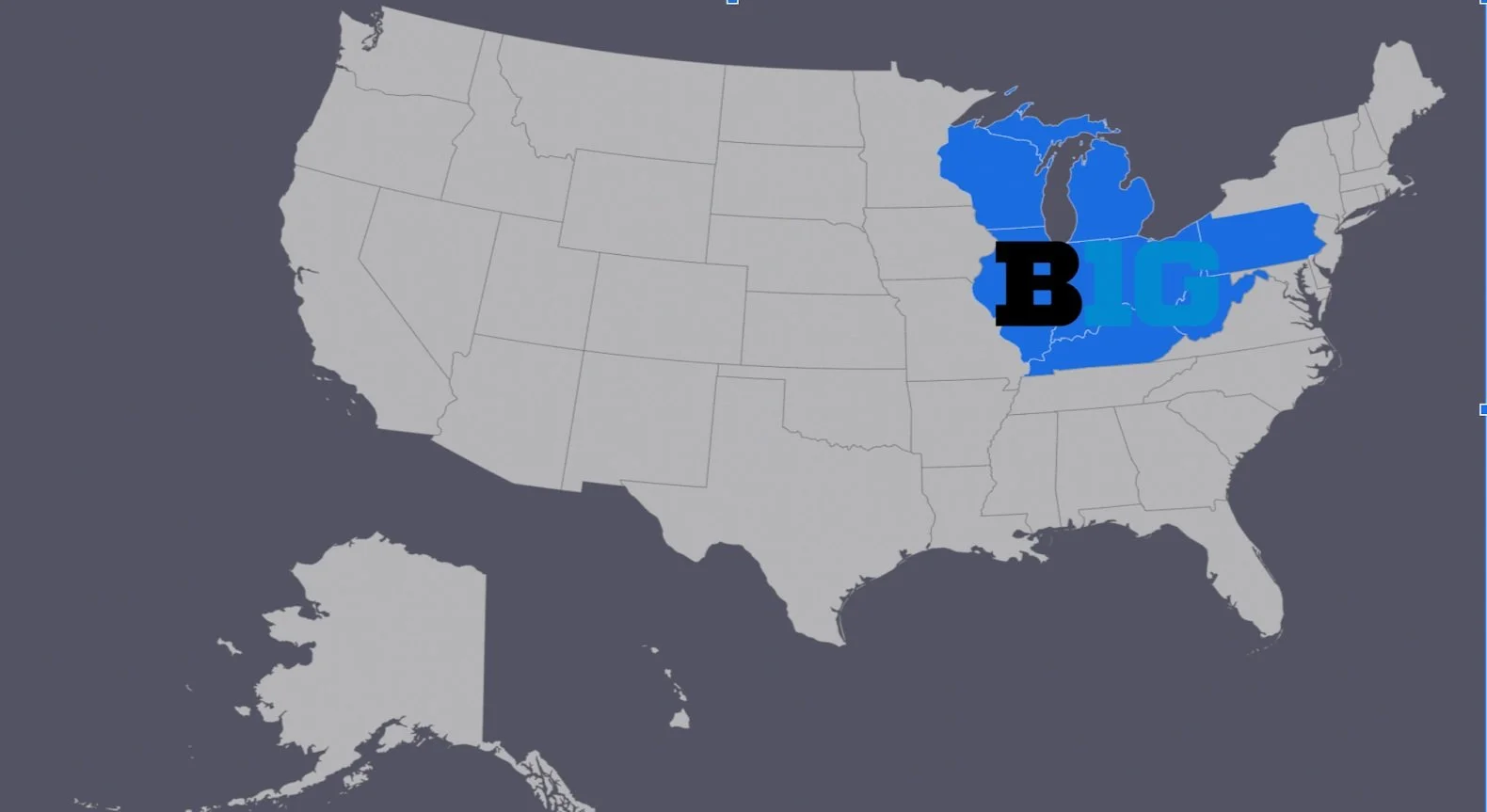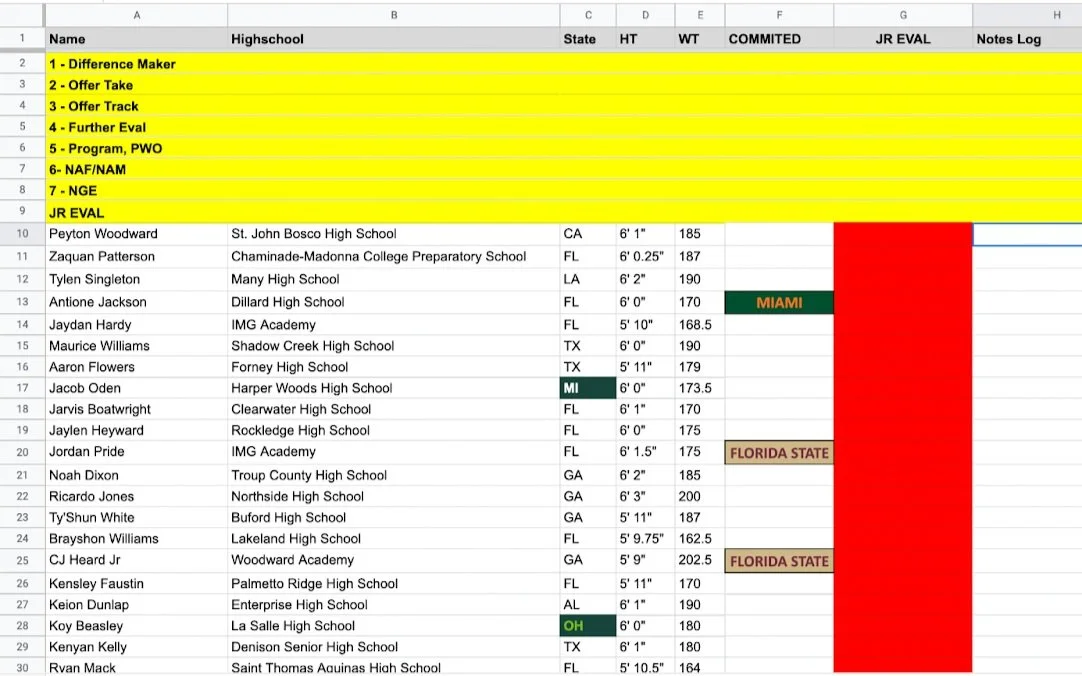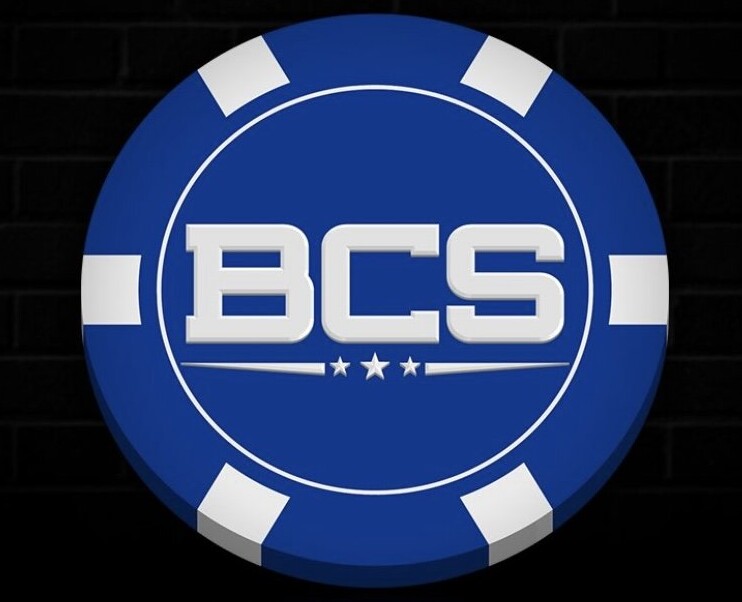For the last year, I have worked as an offensive scouting assistant for a power five football program. I learned how to identify and prioritize high school talent for top-ten power five programs. Now, I will disperse all of what I have learned in collegiate talent evaluation. The secrets to college football are pretty tightly kept, and gatekeeping is the number one issue plaguing newcomers. My goal is to put tools out there, so everyone can chase their dreams. I will let you all in on my philosophy regarding building a college recruiting board for the first time.
1. Understanding recruiting regions.
Every team has divided the country into multiple recruiting regions. Close-in-region states are referred to as “priority states.” Big Ten programs have eight states that are typically priority regions. Michigan, Ohio, Indiana, Illinois, Pennsylvania, Wisconsin, West Virginia, and Kentucky. Priority states are essential to recruiting because they allow recruits to travel reasonably quickly to and from home. These states also permit coaches to travel to see recruits relatively effortlessly. A successful program should be able to secure in-region commits with relative ease. These kids are prioritized for unofficial visits and camps. The ability to recruit nationally is dictated by the size, success, and monetary value of a college program. When I first joined, the team was reeling from a less-than-successful season. Six of our 23 commits were from our home state. However, as success grew, the map in which we drew talent increased. The priority of sifting for talent in-region decreased as the team improved. The ability to recruit nationally emerged. The limitations of travel and distance for kids disappeared with on-field success. The promise of NIL comes with success which increases your recruiting radius. The U.S. dollar has the same value in all 50 states. The ability to recruit nationally is primarily restricted to power five programs. Few Group of Five programs can recruit nationally, with few exceptions, such as Cincinnati, Houston, and BYU.

2. Identifying team specific traits.
Before you can begin finding players, you must identify traits that are essential to the core structure of your team. Each team has an identity set and molded by the head coach and coaching staff. These traits must be universal on the team; every player you pursue has to embody these. Schematics is one piece that factors into these traits. When you look at teams like Mississippi State that run the air-raid offense, they prioritize speed, agility, and endurance. You see teams like Wisconsin who prioritize the run and an aggressive defense. They emphasize size, toughness, and tackling production. These traits can also be called critical factors.
Every team uses a combination of critical factors and position specifics (we will get to these later) to help put talent on a numerical scale. At its core, critical factors are meant to determine if a kid can play at our level and to the team’s standard. It is the lowest level of film evaluation. The “score” generated by the critical factor scale will allow your recruiting office to set a “status “on a prospect before he is moved forward to the position coach. The pace of play and tempo will set standards for what kids you can recruit. Countless factors construct the dynamic of the team you are recruiting or reporting for. After grading a player’s athletic and fit to your scheme, you will assign status and adjust your player’s rank on the board. On the message boards, fans and insiders reference a “take” or a “track” player; those are statuses for the level of recruitment. A “track” player is an offerable player you’re willing to take later in the recruiting cycle. A “take” is a player whose commitment you will take 365 days of the year. The lowest status a player can be assigned on my scale is an NSP (non-suitable prospect).
Examples of status:
Difference Maker: Day One Starter
Offer “Take”: High Level Starter
Offer “Track”: Starting level intangibles
Further Eval: Quality depth player/ not enough film
Not a fit/Not a match (NAF/NAM): Removed from due to size, intangibles, demeanor or financial reasons
Non-suitable prospect (NSP): Player does not project to our level
3. Utilizing position specifics
Position specifics are precisely what they sound like, redeeming traits valued by the position and head coach. Typically, position-specific traits are sub-traits of your critical factors. Physical teams are going to value contact balance, and fast teams are going to value foot quickness. It is essential for your team’s recruiting assistants and director of player personnel to meet with the position coach to create an idea of what is needed to build a sustainable room on a year-to-year basis. When making your board, value traits that are important to you. Do you prefer small, agile running backs or heavy, physical backs? Tall wide receivers who can win above the rim or short, shifty ones who can provide after the catch. Each team typically has a mold or requirement for size. Kansas State, for example, has a pedigree of small, shiftier running backs (Darren Sproles, Deuce Vaughn). At the same time, Wisconsin takes heavier backs such as Braelon Allen, Melvin Gordon, and Jonathan Taylor, each weighing over 210 pounds. You cannot begin to create a position-specific scale without understanding the scheme of your team. Does your team run a three-front or four-front? The three-man down front typically requires a 0-1 tech who will be much heavier than the 3-tech and 5-techs teams usually prefer to recruit. I can tell you from experience our recruiting room had two words in bold and double-underlined on the whiteboard, “No midgets.” A player’s size was everything regarding our coaches’ preferences.
4. Build your scale
To begin building your scale, you must first determine the statuses you want on your board. I recommend the seven I use. Work your way down from high-level starter to not a fit for your team. Each level should generate so you can efficiently prioritize and rank the talent on your board. Some schools use their scale as the hardliner to determine level status, while others are more subjective. In some cases, you may have an offer track grade out better than a take, but your gut or heart will push you to rank the track above the take. To build your scale, you will need five team-specific traits and five positional-specific traits. Each trait should be valued metrically in a 1-10 range. One on my scale is “completely fails to display attributes.” while a ten on my scale is “Displays trait tendencies and mechanics at an elite level.” Your evaluations should be sharp and to the point. College evaluators and coaches don’t have time to read or write NFL-length evaluations. College evaluations are notoriously shorter than NFL evaluations. This is because the college scouts typically need to evaluate around 350 players per position for each class, and each evaluator generally has three positions (1050 per evaluator). In contrast, a complete NFL board is about 650 players, with an entire staff working on completing it. Using a scale allows for faster results than your page-long NFL scouting report.

Peter Jones’ Instagram Commitment photo to the University of Notre Dame
Example: Peter Jones, Malvern Preparatory (Notre Dame commit)
Team specific traits:
Physicality: 8
Strength: 7
Toughness: 9
Speed: 7
Agility: 7
Positional specific traits:
Hand placement: 9
Foot speed: 9
Length: 7
Anchor: 8
Bend: 7
Score: 80/100
Grade: Offer Take: High level Starter
Evaluation: Solid height, good frame with potential to add more bulk. Plays ROT. Large build. Good quickness off LOS. Solid length, can lock out opponents. Good hand placement, keeps them inside. Good 45 set, gets depth quickly. Solid anchor, neutralizes power rushers. Needs to add more fundamental lower-body strength. Good active feet. Distributes power well. Plays with a mean streak.
Examples of Status:
Difference Maker/ Day One Starter: 85-100
Offer “Take”: High Level Starter: 75-84
Offer “Track”: Starting level intangibles: 66-74
Further Evaluation: Quality depth player/ not enough film: 50-73
Walk-on: in-region playmaker with upside: 50-73
Not a fit/not a match: Removed from due to size, intangibles, demeanor or financial reasons
Non-suitable prospect: Player does not project to our level: 0-49
5. How to find players:
Finding players is the easiest step in the process of board building. However, new playmakers emerge every day. A college evaluator must stay on top of other teams’ offers. The usage of media databases is the number one way we find players. We used 247, Rivals, On3, UCReport, and Zcruit as primary resources. Every player with a power five or group of five offer should be evaluated, scored, and ranked. Obviously, at home, you won’t have access to UCReport and Zcruit, so I recommend starting with the Top247 players and working your way to other sites afterward. Start with the current junior class. This fall, begin building your board with 2024 prospects. Using Hudl is the best way to get film. If you can’t find it, I recommend reaching out to high school coaches and ADs. They want as many eyes on their kids as possible. Coaches will be self-motivated to provide you with film after their regular season. It is essential to remember to own your region first before spreading out and looking for talent nationally. When covering a team, it doesn’t hurt to request film on players your beat team is recruiting and form opinions on their targets and commitments.
Three of the top recruiting database:
https://247sports.com/Season/2023-Football/CompositeRecruitRankings/?InstitutionGroup=highschool
https://www.on3.com/db/rankings/consensus-player/football/2023/
https://n.rivals.com/prospect_rankings/rivals250/

6. Construction of board and final words.
The final major step after identifying regions, creating your scale, and finding players is to begin the construction of your board. I recommend Google Sheets over Excel; in Excel, it can be hard to transfer comments between documents. Start by creating columns for your players’ name, high school, state, height, weight, commitment status, and grade. I like to keep a notes tab on the side to document injuries, alum relations, and recruiting updates. This is where it gets tricky. To create a beautiful, organized board, I recommend some knowledge of conditional formatting. Conditional formatting will allow you to set parameters for cells to change color, such as a player with an in-region state denoted by the color green. I will link some tutorials down below. It allows for a solid flow of information about location and players who don’t have evals yet. Adjust your player rankings after scoring them. Drag each row into its prospective spot on the scale. You’re ready to create your unique resume to join the college football ranks. My parting words are everyone sees the game of football differently, trust your eyes and stand with your convictions. Evaluation isn’t perfect. There is no cut-and-dry way to do it; otherwise, they would have already outsourced recruiting staff for robots. Below I have a pre-made, complete 2024 recruiting board. Use it as a template for future boards and a home for your evaluations.
2024 Recruiting Board:
https://docs.google.com/spreadsheets/d/15hScz1R 83PXN2dIwPRZjBrgYls9SvaPUpposxaHM/edit#gid=396073728
Conditional formatting videos:
Conditional Formatting Improvements in Google Sheets by Resultant https://www.youtube.com/watch?v=Cv_OEnNzdnU&ab_channel=Resultant
Conditional Formatting Google Sheets Tutorial by Railsware Product Academy: https://www.youtube.com/watch?v=Oe4jYblXw8k&ab_channel=RailswareProductAcademy
